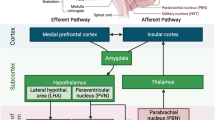Original translational rat model of chronic heart failure provoked by experimental anterior transmural myocardium infarction was employed to examine the preventive action of anxiolytic Afobazole (15 mg/kg/day administered intraperitoneally during the first 15 days after coronary occlusion) on the development of the heart failure assessed in 3 months after infarction. Afobazole prevented the development of pathologic remodeling of the myocardium, maintained its inotropic function, and decreased the plasma level of brain natriuretic peptide known as a biochemical marker of chronic heart failure. In the myocardium, Afobazole down-regulated overexpression of the genes induced in chronic heart failure and assessed by corresponding RNA levels, which code angiotensin (AT1A-R), vasopressin (V1A-R), and glucocorticoid (GR) receptors as well as Epac2 protein. The revealed biochemical changes are consistent with the data on cardioprotective action of Afobazole.
Similar content being viewed by others
References
Kryzhanovskyi SA, Sorokina AV, Stolyaruck VN, Vititnova MB, Miroshkina IA, Tsorin IB, Durnev AD, Seredenin SB. Study of anti-ischemic effect of Afobazole in experimental myocardial infarction. Bull. Exp. Biol. Med. 2011;150(3):316-319.
Seredenin SB, Voronin MV, Abramova EV. Sigma-1 Receptors: A New Pharmacological Target. Eskp. Klin. Farmakol. 2017;80(9):9-19. Russian.
Seredenin SB, Tsorin IB, Vititnova MB, Stolyaruk VN, Chichkanov GG, Kryzhanovskii SA. On the mechanism of anti-ischemic effects of Afobazole. Bull. Exp. Biol. Med. 2013;155(6):760-763.
Stolyaruk VN, Vititnova MB, Tsorin IB, Kryzhanovskyi SA. Investigation of afobasol antifibrillation activity in animals with intact and denervated myocardium. Vestn. Ross. Akad. Med. Nauk. 2010;(4):45-48. Russian.
Bhuiyan MS, Fukunaga K. Targeting sigma-1 receptor signaling by endogenous ligands for cardioprotection. Expert Opin. Ther. Targets. 2011;15(2):145-155.
Ding Y, Chen J, Cui G, Wei Y, Lu C, Wang L, Diao H. Pathophysiological role of osteopontin and angiotensin II in atherosclerosis. Biochem. Biophys. Res. Commun. 2016;471(1):5-9.
Gray GA, White CI, Castellan RF, McSweeney SJ, Chapman KE. Getting to the heart of intracellular glucocorticoid regeneration: 11b-HSD1 in the myocardium. J. Mol. Endocrinol. 2017;58(1):R1-R13.
Grothusen A, Divchev D, Luchtefeld M, Schieffer B. Angiotensin II type 1 receptor blockade: high hopes sent back to reality. Minerva Cardioangiol. 2009;57(6):773-785.
Nio Y, Matsubara H, Murasawa S, Kanasaki M, Inada M. Regulation of gene transcription of angiotensin II receptor subtypes in myocardial infarction. J. Clin. Invest. 1995;95(1):46-54.
Oakley RH, Cidlowski JA. Glucocorticoid signaling in the heart: A cardiomyocyte perspective. J. Steroid Biochem Mol. Biol. 2015;153:27-34.
Ren R, Oakley RH, Cruz-Topete D, Cidlowski JA. Dual role for glucocorticoids in cardiomyocyte hypertrophy and apoptosis. Endocrinology. 2012;153(11):5346-5360.
Rog-Zielinska EA, Craig MA, Manning JR, Richardson RV, Gowans GJ, Dunbar DR, Gharbi K, Kenyon CJ, Holmes MC, Hardie DG, Smith GL, Chapman KE. Glucocorticoids promote structural and functional maturation of foetal cardiomyocytes: A role for PGC-1α. Cell. Death Differ. 2015;22(7):1106-1116.
Schmidt M, Dekker FJ, Maarsingh H. Exchange protein directly activated by cAMP (Epac): a multidomain cAMP mediator in the regulation of diverse biological functions. Pharmacol. Rev. 2013;65(2):670-709.
Tilley DG, Zhu W, Myers VD, Barr LA, Gao E, Li X, Song J, Carter RL, Makarewich CA, Yu D, Troupes CD, Grisanti LA, Coleman RC, Koch WJ, Houser SR, Cheung JY, Feldman AM. b-Adrenergic receptor-mediated cardiac contractility is inhibited via vasopressin type 1A-receptor-dependent signaling. Circulation. 2014;130(20):1800-1811.
Zhu W, Tilley DG, Myers VD, Tsai EJ, Feldman AM. Increased vasopressin 1A receptor expression in failing human hearts. J. Am. Coll. Cardiol. 2014;63(4):375-376.
Author information
Authors and Affiliations
Corresponding author
Additional information
Translated from Byulleten’ Eksperimental’noi Biologii i Meditsiny, Vol. 165, No. 5, pp. 605-609, May, 2018
Rights and permissions
About this article
Cite this article
Kryzhanovskii, S.A., Kozhevnikova, L.M., Tsorin, I.B. et al. On the Mechanism of the Cardioprotective Action of σ1 Receptor Agonist Anxiolytic Fabomotizole Hydrochloride (Afobazole). Bull Exp Biol Med 165, 660–664 (2018). https://doi.org/10.1007/s10517-018-4236-1
Received:
Published:
Issue Date:
DOI: https://doi.org/10.1007/s10517-018-4236-1




